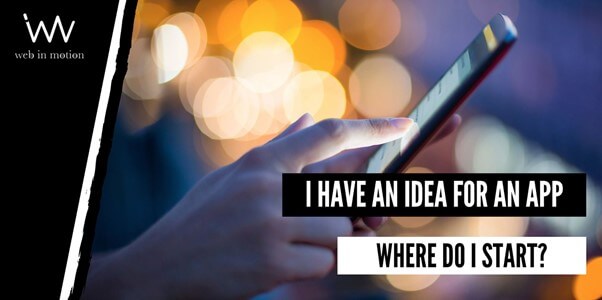
I have an idea for an app, where do I start?
Maybe you were daydreaming or just scrolling down social media feeds, and suddenly it shook you: a fantastic idea for an app! It stroked you as a solution for a daily chore, or as an improvement for an already existing service, or maybe it is a fun game or an app for our business.
This may sound like an exciting moment, and you may feel some adrenaline. But after those “eureka” minutes, you’re probably asking yourself, “now what?”… How do I develop an app? Or, how can I sell my app idea?
The first thing you need to know is that thousands of people are trying to build an app, and many of them don’t also don’t have a clue as to where to start, so you are not alone. In this post, we will talk about some things to consider after you’ve come up with an idea for an app. These are some steps you want to consider before the development phase.
Before we go on to those steps, you may want to answer some questions about your idea. These questions will help you guide the subsequent process of ideation, briefing, and development:
- Do you have enough time to work on this app? Or maybe you are thinking of hiring someone to do it?
- You want to make it your primary business, or is it a side activity?
- Do you have enough resources to hire developers?
- Are you sure that your users will love the product after this app is launched as much as you love the idea?
Think about these questions thoroughly; maybe write your answers down to make them clear to you and possible co-founders.
Step 1: Define your investment strategy
Before jumping into the actual creation of an app, you must know this is not a cheap process. On the contrary, it may cost a lot of money to develop an app, especially if you plan on doing it with experts. And this is the most advisable way of doing it, requiring many hours of work and meetings.
So, you may want to define it in an early stage; how will you pay those developers? Maybe with a loan or a capitalist partner? Do your research on what to expect in terms of cost, and then elaborate on your funding strategy.

Step 2: Do your research
Look out for similar apps or services that resemble your idea, supposing there are already likewise apps. If not, research the market needs on your concept. Remember, the app business is highly competitive; there might be tens or hundreds of similar apps fighting for users worldwide.
You will need to think about the industry space that your app falls into and then research that sector carefully. Next, study your competition and their apps to note what they are doing right and avoid their flaws.
Don’t be discouraged if an existing app seems to do the same thing as your idea. This doesn’t mean that you are too late for your vision; you just need to find ways in which your app can be better or different from your competitors.
Step 3: Avoid these app ideas.
After the initial research, if you still consider your app will have a proper user response, try to answer the following questions. There aren’t formulas to decide if your idea will be successful or not, but we have some clues in terms of things that usually work and those that maybe won’t.
- Is your idea very similar to an app that already exists but a little bit different?
- Is it clear to you how your app might deliver value to users?
- Are you trying to build an app that sounds good to you but hasn’t tried out?
- Is making your app something that you’re passionate about?
If you checked any of these questions as “yes,” you should probably spend some more time testing and thinking about your idea or asking experts about it.
Step 4: Outline your app idea
Now your goal is to build a creative brief that describes all the details of your app idea. Here are some items that your brief should include:
- A catchy app name that stands out and is easy to remember.
- A clear pitch to present the problem and how your app solves it. This has to retain both user and investor interest.
- The target demographic you want to attract and why.
- The features you’d like to include in your app and why they will benefit your users.
- A detailed navigation map to explain how users will interact with your app.
- Market research that explains why your app will appeal to your intended user base.

Step 5: Determine your monetization plan
The next thing to do is think about how you are going to make money with your app. Although most apps are free to download, that doesn’t mean you will not earn something with your creation. There are multiple ways to monetize your app. These are the most common strategies:
- Flat fee: you charge users a fixed price to download your app (this strategy is usually reserved for premium software like Adobe Suite products).
- Third-party ads: this is a wide-used system in which you include third-party banners or pop-up ads within the app and then receive income each time the ads are displayed, or when a user clicks on the ad, or when a user installs the third-party app.
- Charge for add-ons and extra features: you may offer a “freemium” app, where some are free, and others have to be bought.
Step 6: Make a prototype of your app idea
At this point, it is time to test your idea, which will require you to create a prototype, a model of the final app. There are three types of app prototypes depending on which stage of the development you stand-in.
1. Conceptual:
The conceptual prototype is a schematic description of potential app screens. This is an early prototype, and it is beneficial to solve usability issues since the beginning of the development.
2. Interactive:
The conceptual prototype is a schematic description of potential app screens. This is an early prototype, and it is beneficial to solve usability issues since the beginning of the development.
3. Animated:
This the farthest a prototype can go; it can simulate how the final app will work. At this stage, the user interface designer (UI/UX designer) will draft the process of program interaction with the future users.
Step 7: Find your ideal developer partner
Finally, it’s time to find an experienced app development company (although maybe if you already built an animated prototype, you already have one). This team will make your dreams come true, so you will need to join an agency that respects your ideals while also bringing you back to earth when your expectations exceed reality or user’s needs.


